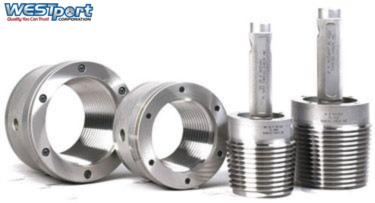
API Regular Rotary Shoulder Connection Thread Plug and Ring Gages
API Regular Rotary Shoulder Connection - Thread Plug and Ring Gages - API Spec 7-2
API Spec 7-2 is a standard that specifies the requirements for threading and gauging of rotary shouldered connections used in the petroleum and natural gas industries.
| PART # | DESCRIPTION | PRICE |
| WPREG-1-P | 1" Reg Thread Plug Gage | call |
| WPREG-1-R | 1" Reg Thread Ring Gage | call |
| WPREG-1-1/2-P | 1-1/2" Reg Thread Plug Gage | call |
| WPREG-1-1/2-R | 1-1/2" Reg Thread Ring Gage | call |
| WPREG-2-3/8-P | 2-3/8" Reg Thread Plug Gage | call |
| WPREG-2-3/8-R | 2-3/8" Reg Thread Ring Gage | call |
| WPREG-2-7/8-P | 2-7/8" Reg Thread Plug Gage | call |
| WPREG-2-7/8-R | 2-7/8" Reg Thread Ring Gage | call |
| WPREG-3-1/2-P | 3-1/2" Reg Thread Plug Gage | call |
| WPREG-3-1/2-R | 3-1/2" Reg Thread Ring Gage | call |
| WPREG-4-1/2-P | 4-1/2" Reg Thread Plug Gage | call |
| WPREG-4-1/2-R | 4-1/2" Reg Thread Ring Gage | call |
| WPREG-5-1/2-P | 5-1/2" Reg Thread Plug Gage | call |
| WPREG-5-1/2-R | 5-1/2" Reg Thread Ring Gage | call |
| WPREG-6-5/8-P | 6-5/8" Reg Thread Plug Gage | call |
| WPREG-6-5/8-R | 6-5/8" Reg Thread Ring Gage | call |
| WPREG-7-5/8-P | 7-5/8" Reg Thread Plug Gage | call |
| WPREG-7-5/8-R | 7-5/8" Reg Thread Ring Gage | call |
| WPREG-8-5/8-P | 8-5/8" Reg Thread Plug Gage | call |
| WPREG-8-5/8-R | 8-5/8" Reg Thread Ring Gage | call |
Rotary shouldered connections are threaded joints that connect drill pipe, drill collars, subs, and other tubular components. They are designed to withstand high torque, tension, and bending stresses during drilling operations.
API Regular Rotary Shoulder Connection thread plug and ring gages are used to inspect the quality and conformity of the thread connections. They are manufactured in accordance with the dimensions, tolerances, and gauging practices specified in API Spec 7-2. The thread plug gages are used to check the internal threads (box) of the connection, while the thread ring gages are used to check the external threads (pin) of the connection.
To use these gages properly, the following steps are recommended:
- Clean the threads and gages thoroughly and apply a thin film of thread compound or lubricant.
- Insert the thread plug gage into the box and rotate it by hand until it makes contact with the thread flank. The gage should enter the box smoothly and easily, without binding or jamming. The gage should not enter more than one full turn beyond the hand-tight position.
- Remove the thread plug gage and inspect it for any damage or wear. If the gage is damaged or worn, it should be replaced or recalibrated.
- Place the thread ring gage over the pin and rotate it by hand until it makes contact with the thread flank. The gage should fit over the pin smoothly and easily, without binding or jamming. The gage should not fit more than one full turn beyond the hand-tight position.
- Remove the thread ring gage and inspect it for any damage or wear. If the gage is damaged or worn, it should be replaced or recalibrated.
- If the thread plug and ring gages fit within the specified limits, the thread connection is acceptable. If the gages do not fit within the specified limits, the thread connection is unacceptable and should be rejected or repaired.
If you have any technical questions; our team of engineers has served on many different API gaging subcommittees with over 100 years of experience. We are here to assist you with any questions or special requirements you may have.
You can contact us at: 888-400-4243 with any questions or quoting you require or email your prints to quote@westportcorp.com.


